Unless you live right in the middle of a crop field or a golf course, your lawn is likely not receiving direct sunlight. Most lawn grasses need at least four to six hours of direct sun for healthy growth. In shaded areas with partial or dappled sun, grass plants struggle to grow. In this article, we’ll discuss shade tolerant grass.
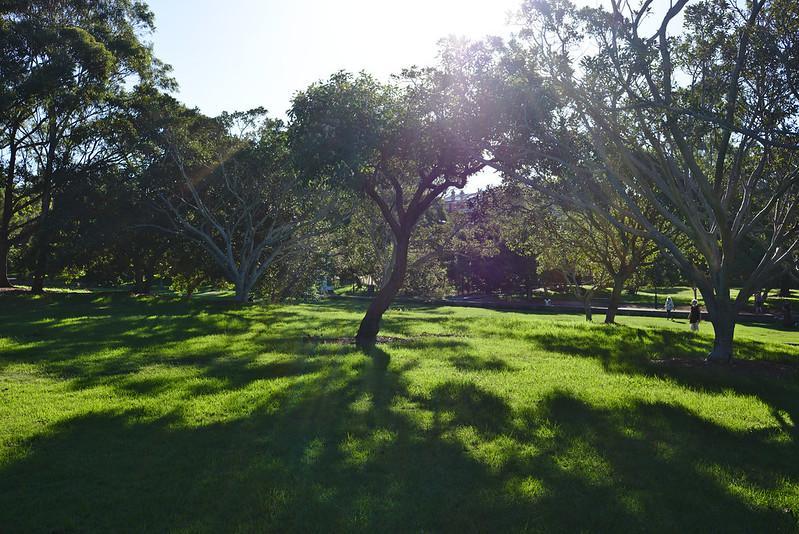
Shade tolerant grasses can keep your lawn lush and green in an area with limited sunlight.
Growing grass in a shaded area is a challenge for lawn owners and gardeners worldwide. Shaded areas or areas with dappled sunlight present a significant challenge in creating and maintaining a healthy lawn. Turf grasses growing in areas with a partial sun are usually thin and patchy.
Like all plants, growing grass requires a few hours of direct sun daily. Direct sunlight is vital for the process by which grass produces its food and energy, i.e., photosynthesis. The more sunlight they can absorb, the better the grass grows. Most grasses can grow at an optimal rate with a few hours of partial sun daily.
However, in shady areas such as those around buildings and large trees, getting a partial sun daily for even a few hours is not possible. This is where shade-tolerant grasses come in. You can find grass seeds for numerous shade-tolerant species in your supermarket. However, creating a beautiful lawn in shaded spots takes more than just good grass seed.
Read our article to learn more about what you can do to maximize your chances of growing grass in a dense shade and what grass species is best for your lawn. Happy Reading!
Cool-season grasses Vs. Warm-season grasses
Depending on where you live, you will have to choose between cool-season grasses and warm-season grasses. If you choose a grass that does not match your area, the grass will not flourish properly, let alone survive in full shade. Here’s the link to a guide from the University of Kentucky that you can use to determine the best grass for your area.
We will also individually discuss some examples of warm and cool seasons as we move forward in the article. We will look at their pros and cons to help you decide the best grass for your lawn. However, first, let’s take a look at the general differences between these two grass types for developing a better understanding
| Cool-season grasses | Warm-season grasses |
| Cool-season grasses flourish in spring and fall | Warm-season grasses flourish in late spring and throughout the summer |
| Have higher water and nutrient requirement | Able to grow in nutrient-poor soil and are somewhat drought resistant |
| Tend to be low growing | Tend to be high growing |
| More likely to harbor pests | Usually support a mix of insect populations |
| Inexpensive and readily available grass seed | Grass seed availability & affordability is an issue |
Now let’s take a look at a few examples of warm-season and cool-season grasses in detail.
Warm-season grasses
Centipede grass
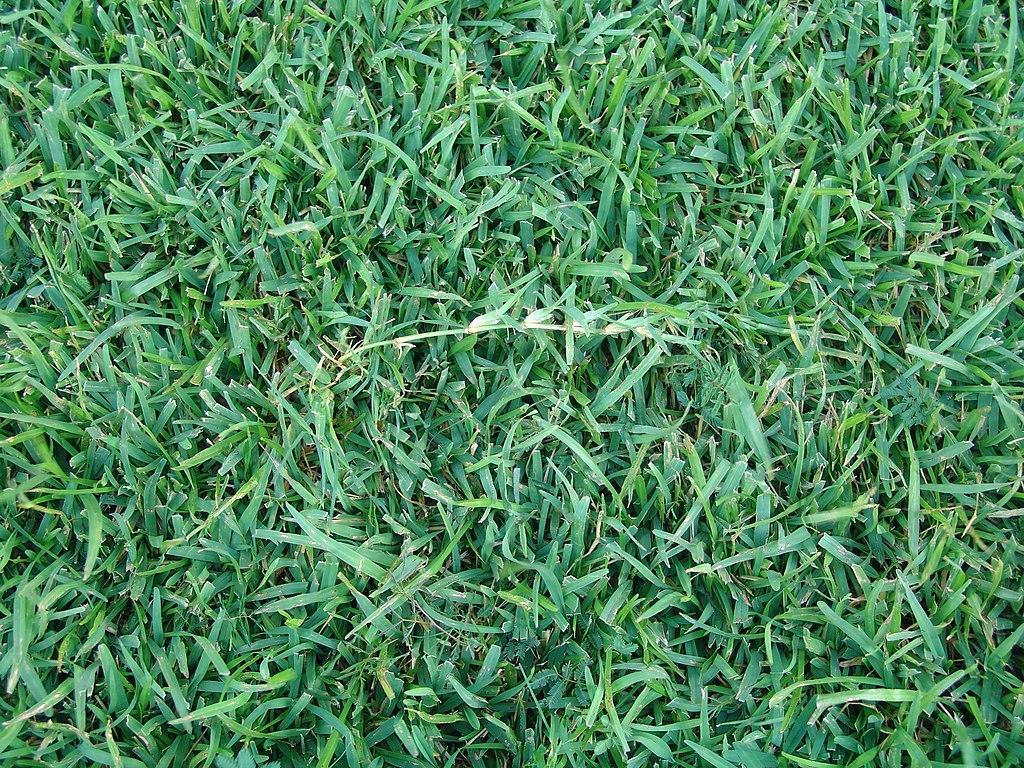
Centipede grass does not develop deep roots. So, it doesn’t have an excellent drought tolerance.
It is a warm-season grass that has moderate shade tolerance. Being a moderately shade-tolerant species, it requires at least a few hours of full sun every day and cannot survive in full shade. It is very low maintenance and requires only a little fertilizer and infrequent mowing. The grass is an excellent choice for areas with light shade; however, the grass is not suitable for shady areas with high foot traffic.
Moreover, despite being warm-season grass, it does not do very well in drought because the grass roots do not penetrate very deep into the soil. In some areas, it is also considered a weed. It can grow in poorly fertile soils and shady spots where other plants struggle to grow. The grass is also highly susceptible to damage from nematodes.
Another thing to keep in mind is that the grass is very high in lignin, which makes decomposition very slow. Slow decomposition results in frequent thatch buildup, interfering with the grass growing below.
Centipede grass requirements
- Requires at least six hours of full sun
- Does not survive high soil pH
- Does well in sandy and acidic soils
- Over-fertilizing can reduce its cold tolerance
- Grass grows poorly in poorly drained soils
- Has a poor salt tolerance
- Frequent irrigation can damage the grass
- For the grass to grow properly, a mowing height of around 1½ to 2 inches must be maintained
Related: How to Plant Bermuda Grass | Bermuda Grass Growth Stages and Care
Zoysia grass
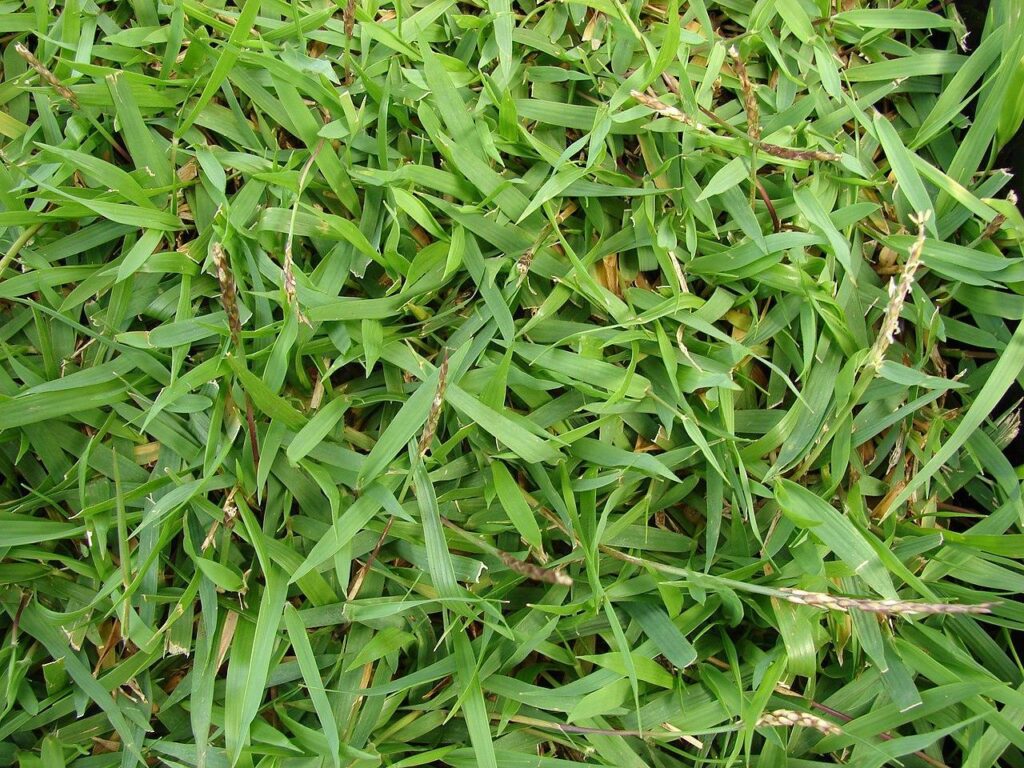
A shade tolerant variety that grows well in filtered sunlight.
It was introduced from Asia into the United States, and it grows best during the warm months of summer, spring, and early fall. During these months, it thrives and produces a dense, attractive lawn. In addition, the grass is one of the most cold-tolerant of all the warm-season grasses. The use of grass seed is not recommended for establishing a Zoysia lawn as the grass grows slowly compared to other grasses.
However, its shade tolerance is considerably better than centipede grass, making it an excellent choice for areas with partial shade. The grass is usually grown by sodding or plugging. Also, the blades of the grass are tough and grow densely together, making it an excellent choice for areas with high traffic.
Zoysia grass requirements
- Requires three to four hours of sunlight daily
- It grows best in transition and southern regions of the country
- For optimal growth, mowing height should not be more than 1 to 2 inches.
- Prefers acidic soil with a pH of around 6 to 6.5
- Needs around one inch of irrigation or rainfall per week
- Depending on the soil, the grass might need a nitrogen fertilizer
- Grow grass in direct sunlight for best results
St. Augustine Grass
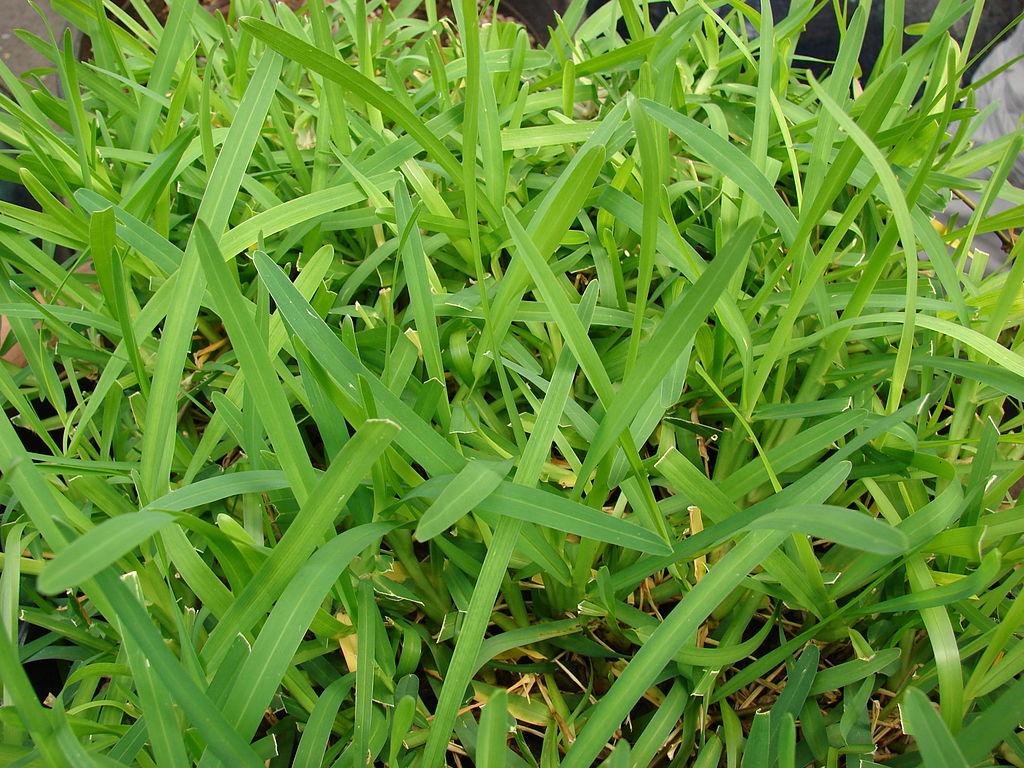
The grass can grow well in low light conditions.
Another grass to grow in warm-season areas is the St. Augustine grass. The grass can tolerate shade for about twenty hours a day. However, the soil cannot survive extended periods of cold weather. Several shade-tolerant cultivars of St. Augustine grass have been developed over the years. Some of the most shade-tolerant cultivars include Palmetto, Bitter Blue, Sapphire, and Seville.It is the best grass to grow in residential and commercial areas as it can survive hours of dappled sunlight daily. Moreover, as long as the fertility and drainage are adequate, St. Augustine grass can grow well in many soil types. However, you should note that St. Augustine grass is not very tolerant of high-traffic areas.
St. Augustine grass requirements
- To grow grass, you’ll need at least 4 to 6 hours of sunlight
- Optimal pH for growing grass is around 6 to 7.5
- Soil must be adequately drained and fertilized
- Requires adequately moist soil for optimal growth
- Mowing height should be set around 3 inches
- Prone to numerous pests and requires occasional pesticide use
- Might also need periodic weed control
Cool season grasses
Fescue grass
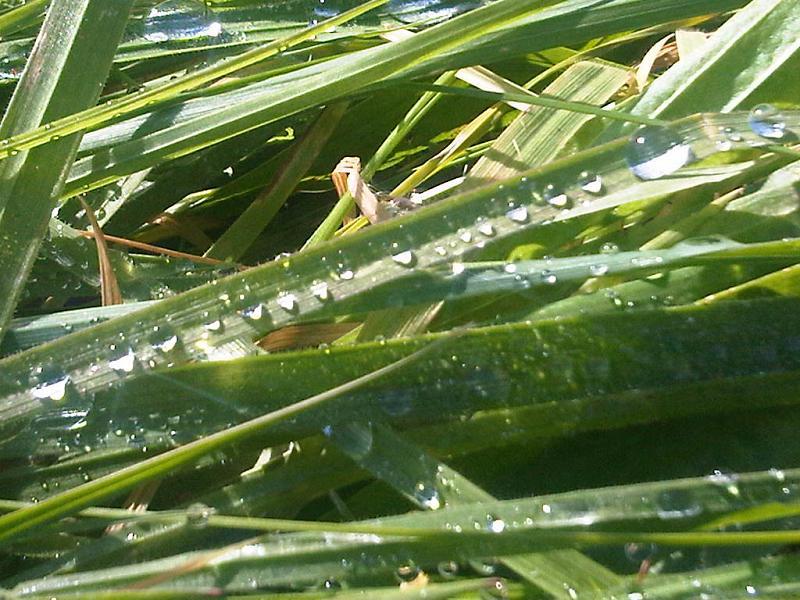
Due to its extensive root network, fescue grass is quite drought tolerant.
Fescue grass is a cool-season grass that can grow well in shaded areas and inadequately fertilized regions as well. However, it does not mean that it can survive in shady areas with a dense shade for long periods. Many shade-tolerant cultivars of fescue grass are available in the market, such as tall fescue, fine fescue, and red fescue. Tall fescue is considered the most shade tolerant of all its cultivars.
Fescue grass is highly drought-tolerant. You do not have to water the grass in a dense shade frequently. The only exception is areas with large trees. Large tree roots can suck up all the water in these shady spots, leaving very little water for the small grass roots. The best time to grow fescue grass is during early spring.
Fescue grass requirements
- Requires 4 to 6 hours of direct or dappled sun daily
- Cannot grow in highly dense shade
- Might require occasional use of nitrogen fertilizers
- Requires acidic to neutral soil for optimal growth
- Able to grow in many soil types if they are well-drained and fertilized
- Requires infrequent watering as it has deeper roots compared to other grasses
- Mowing height must be set around 4 inches for optimal growth
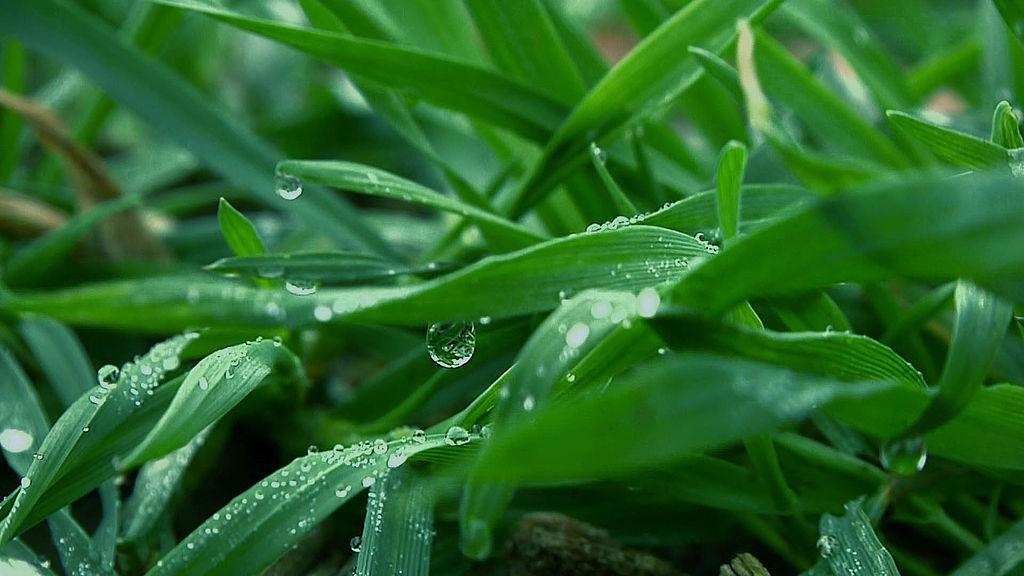
Perennial Rye grass can survive for extended periods if it gets 4 to 5 hours of sunlight in a day.
Among cool-season lawn grasses, rye grass and its various cultivars particularly stand out. Rye grass is able to grow in places where it is too wet for other types of grasses to show satisfactory growth. They are water-loving grasses, and their growth considerably slows down during periods of drought.
However, ryes grass can survive for extended periods in shaded areas. Particularly among lawn grasses, perennial rye grass is very tolerant of shady spots. These grasses make an attractive lawn. They are also considered high-quality forage for animals because of their excellent digestibility.
Despite being cool-season grass, Rye grass has an excellent tolerance against hot weather. If the soil is kept moist, it can easily survive temperatures above 90 degrees.
Ryegrass requirements
- Requires 4 to 5 hours of sunlight
- Requires well-fertilized soil
- A soil pH of 5.5 to 7.5 is needed for its optimal growth
- Grows well in sandy and poorly-drained clay soils
- Should be watered vigorously two to three times a week
- Mowing height should be set around 1 or 2 inches
- Prone to fungal diseases in wet conditions so requires occasional pesticide treatment
Related: Pros And Cons of Using Straw To Cover Grass Seed In A Newly Seeded Lawn
Bluegrass
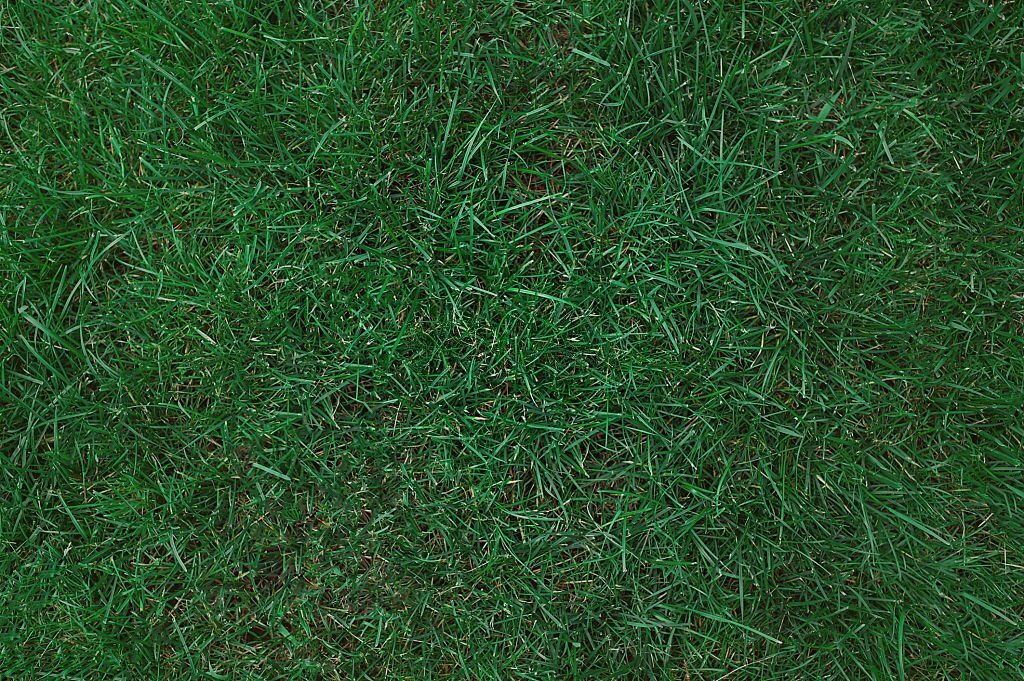
Various cultivars of blue grass have long been used as turf grasses, such as rough bluegrass and Kentucky bluegrass. In fact, it was Kentucky blue grass that made sod production possible in the northern regions. On the other hand, rough bluegrass is very well adapted for wet, shady, and cool areas. However, if you live in a dry and hot area, you should not use rough bluegrass as it dies in scorching weather, leaving bare spots in your turf.
Nonetheless, if you have a lawn covered with dense shade, you cannot go wrong with bluegrass. If conditions are kept moist, some shade-tolerant cultivars can go as long as twenty hours a day without direct sun for extended periods of time. However, blue grasses are heavy thatch producers. So, they might increase lawn maintenance costs over the long run.
Bluegrass requirements
- Temperature should be between 50°F and 65°F for optimal growth
- Mowing height should be set at 2 inches for best grass growth
- Blue grass has a high water requirement, so they need frequent watering
- pH should be maintained between 6 and 7
- They grow best in fertile soil, so you might need to use a fertilizer from time to time
- Around 4 hours of direct or indirect sunlight is needed for optimal growth
- Prone to weeds and pests, so the use of herbicides and pesticides will be needed
How to grow grass in shaded areas?
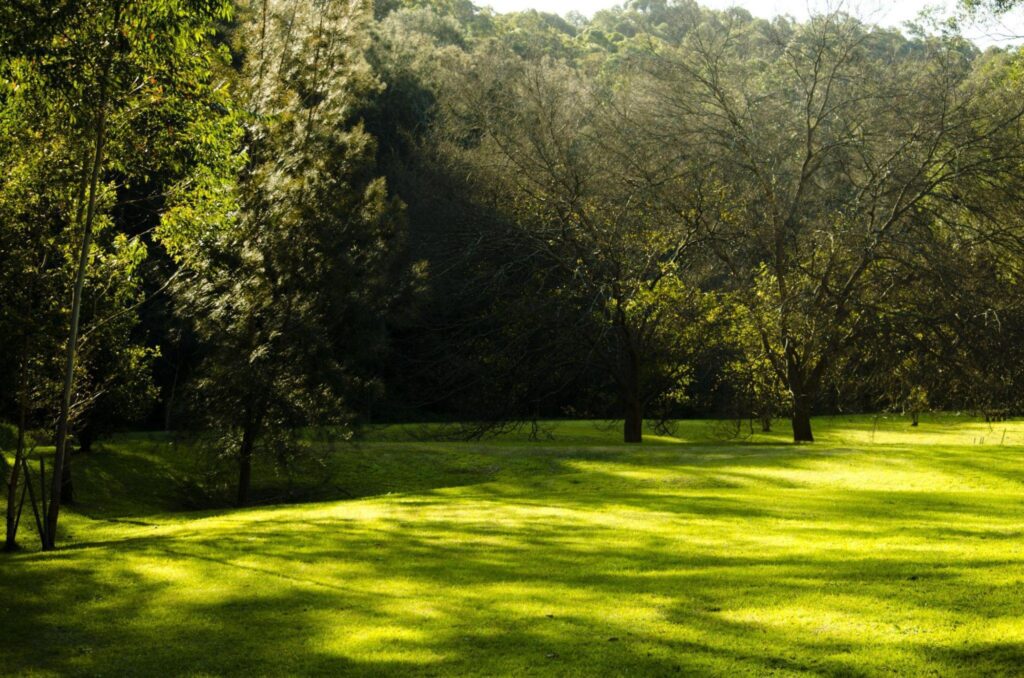
Even the most shade tolerant grasses need some sunlight to grow.
Even though the grass types that we discussed above are quite shade-tolerant and able to grow without full sun, some things still need to be kept in mind while planting grass in shady areas. This will ensure that your grass grows quickly and forms a dense turf.
Also, keep in mind that being shade-tolerant does not mean that grass will be able to grow without sunlight. To grow properly, even the most shade tolerant grass will need a few hours of sunlight every day (either direct or indirect, i.e., filtered, dapples, etc.).
Here are a few tips that you can use to grow grass in the shade:
- First of all, evaluate the amount of sunlight that falls on your lawn. Growing grass, even the shade-tolerant cultivars, will be tough if it is less than 4 hours a day.
- Find a grass that works best in your area depending on climate, soil type, and rainfall. You can read the guide above to find some examples and valuable insights.
- Set the mowing height as tall as possible. It ensures the development of deep roots and keeps your lawn clean of weeds. Also, a high mowing point makes the grass more tolerant to drought and hot weather.
- Try to reduce the stress on grass as much as possible. It involves reducing foot traffic in the areas and maintaining healthy lawn conditions.
- Use a shade tolerant grass seed mix to ensure that the grass will grow even if a single species fails to get hold in your lawn.
- Supplement the grass grown in the shade more frequently. These grasses are already deprived of sunlight which is the fundamental driving force for their metabolism. If they also lack nutrients, their growth will be severely affected.
- If you see any weeds or pests in your lawn, treat them as soon as possible. Weeds can compete with the grass for water, nutrients, and already deprived sunlight. At the same time, pests can ruin grass roots and blades, further reducing the productivity of grass.
Shade tolerant grass alternatives
If all fails and even shade-tolerant grasses cannot grow in your lawn, you can try some tall grasses and ornamental grass species in your yard to cover the bare spots. For example, fall-blooming reed grass, blue grama grass, Korean feather reed grass, and autumn moor grass have been used extensively in lawns to decorate shady areas.
Frequently Asked Questions
What kind of grass grows best in the shade?
Many types of grasses and grass cultivars can grow well in shady areas. However, the ideal choice will vary from place to place and depending on the soil quality, weather conditions, and rainfall. Please read our guide above to find out more.
Is there a grass that will grow in full shade?
Grass, just like other plants, needs sunlight to produce its food. So, no matter what you do, you cannot grow lush green and dense grass in an area where there is always shade.
How to grow grass under trees?
You will need a shade-tolerant variety to grow grass under the shade of a tree. Also, you will need to water and fertilize the area more frequently. Again, it is because the large tree roots will compete with grass roots for water and nutrients very aggressively.
Sources for Further Reading
- Selecting and Managing Lawn Grasses for Shade | NC State Extension Publications. Retrieved 14 April 2022, from https://content.ces.ncsu.edu/selecting-and-managing-lawn-grasses-for-shade
- Growing Grass in the Shade | University of Maryland Extension. (2022). Retrieved 14 April 2022, from https://extension.umd.edu/resource/growing-grass-shade
- Grasses in Shade: Establishing and Maintaining Lawns in Low Light. Retrieved 14 April 2022, from https://extension.missouri.edu/publications/g6725
Hope you like our shade tolerant grass article. Please also check out our other articles:
What Is Digging Holes In Your Lawn? Causes and Solutions
Common Lawn Weeds With White Flowers (And How To Get Rid Of Them?)
Common Lawn Weeds With Yellow Flowers (And How To Get Rid Of Them?)







